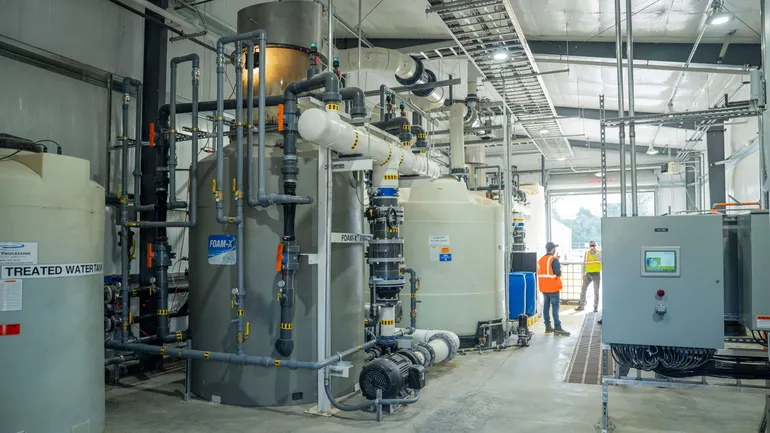La Plata Wastewater Plant Faces Permit Violations Amid State-Mandated Upgrades – The BayNet

Report on La Plata Wastewater Treatment Plant Operations and Sustainable Development Goal Alignment
Executive Summary
The Town of La Plata’s wastewater treatment facility is undergoing significant upgrades to align with state-level environmental mandates aimed at nutrient reduction. These efforts directly support several United Nations Sustainable Development Goals (SDGs). However, operational challenges, including discharge permit violations, have emerged during this transition. This report outlines the context of the upgrades, the nature of the violations, the corrective actions being implemented, and the project’s alignment with global sustainability targets.
Project Context and Alignment with Sustainable Development Goals (SDGs)
The facility upgrades are mandated by the Maryland Department of the Environment (MDE) under its Enhanced Nutrient Removal program. The primary objective is to reduce nitrogen and phosphorus discharges, a critical step in protecting regional water bodies.
- SDG 6: Clean Water and Sanitation: The core mission of the plant upgrades is to improve wastewater treatment, directly contributing to Target 6.3, which aims to improve water quality by reducing pollution and halving the proportion of untreated wastewater.
- SDG 14: Life Below Water: By reducing nutrient pollution, the project addresses Target 14.1, which seeks to prevent and significantly reduce marine pollution from land-based activities. This is vital for the health of local and regional aquatic ecosystems.
- SDG 11: Sustainable Cities and Communities: Modernizing wastewater infrastructure is fundamental to creating resilient and sustainable urban environments, in line with Target 11.6, which focuses on reducing the environmental impact of cities through improved waste management.
Operational Challenges and Permit Violations
The Town of La Plata is actively collaborating with the MDE to address violations of the plant’s discharge permit. An initial assessment indicates these issues are linked to two primary factors:
- Complications arising during the phased implementation of plant upgrades.
- Periods of excessive rainfall overwhelming the system’s current capacity.
These incidents represent a temporary setback in achieving the consistent water quality standards required by SDG 6. It is confirmed that the town’s drinking water supply remains safe and has not been impacted by these events.
Corrective Actions and Strategic Partnerships (SDG 17)
In a demonstration of commitment to SDG 17: Partnerships for the Goals, the Town has engaged external expertise and is working collaboratively to resolve the issues.
- Expert Consultation: The Town commissioned CDM Smith, an international engineering firm specializing in water and environmental science, to conduct a thorough operational assessment.
- Recommendations Report: CDM Smith has delivered a professional report detailing the causes of the violations and providing a set of actionable recommendations.
- Implementation Plan: Upon approval by the Town Council, the proposed recommendations and enhanced monitoring systems will be implemented immediately to ensure compliance and advance the facility’s sustainability objectives.
Public Engagement and Future Outlook
The Town of La Plata is committed to transparency and maintaining compliance with all environmental regulations. Further information will be shared with the public as it becomes available. An operational update will be presented to the Town Council at a public business meeting.
- Meeting Date: July 29, 2025
- Time: 6:00 PM
- Location: Town Hall, with options for online attendance via the Town’s official website.
The successful implementation of the corrective measures will realign the plant’s operations with the long-term goals of providing effective sanitation, protecting aquatic life, and contributing to a sustainable community, as envisioned by SDGs 6, 11, and 14.
Relevant Sustainable Development Goals (SDGs)
-
SDG 6: Clean Water and Sanitation
- The article’s core subject is the Town of La Plata’s wastewater treatment plant, its operational challenges, and upgrades. This directly relates to ensuring the availability and sustainable management of water and sanitation. The text explicitly mentions “wastewater treatment plant,” “discharge permit,” and efforts to resolve violations, all of which are central to SDG 6.
-
SDG 11: Sustainable Cities and Communities
- The issue concerns municipal infrastructure within the “Town of La Plata.” Managing wastewater is a critical service for making a town or city safe, resilient, and sustainable. The article discusses plant upgrades and compliance, which are essential for reducing the environmental impact of the community.
-
SDG 14: Life Below Water
- The article states that the plant upgrades are part of a state-mandated program to “reduce nutrients in the region,” specifically “to reduce nitrogen and phosphorus discharges.” These nutrients are major sources of pollution for water bodies, leading to eutrophication that harms aquatic ecosystems. This directly connects to the goal of conserving and sustainably using marine resources.
-
SDG 17: Partnerships for the Goals
- The article highlights collaboration between multiple entities to solve the problem. The “Town of La Plata is working closely with the Maryland Department of the Environment (MDE)” and has also “engaged CDM Smith, a reputable, international engineering firm.” This multi-stakeholder partnership between local government, state government, and a private international firm exemplifies the collaborative approach promoted by SDG 17.
Specific SDG Targets
-
Target 6.3: Improve water quality by reducing pollution
- The article is centered on efforts to improve the quality of discharged water. The MDE’s “Enhanced Nutrient Removal program” and the plant upgrades are specifically designed to “reduce nitrogen and phosphorus discharges,” which is a form of pollution. The “violations of the Town’s discharge permit” indicate a failure to meet water quality standards, which the town is now working to rectify.
-
Target 11.6: Reduce the adverse per capita environmental impact of cities
- The wastewater treatment plant’s function is to manage municipal waste and reduce the town’s environmental footprint. The permit violations represent an adverse environmental impact, and the upgrades and corrective actions described are direct efforts to reduce this impact.
-
Target 14.1: Prevent and significantly reduce marine pollution of all kinds, in particular from land-based activities
- The article explicitly mentions reducing “nutrient pollution” (nitrogen and phosphorus) originating from a land-based source (the town’s wastewater plant). This action is a direct response to preventing the type of pollution that degrades coastal and marine ecosystems.
-
Target 17.17: Encourage and promote effective public, public-private and civil society partnerships
- The article describes a public-private partnership in action. The Town of La Plata (public) is working with the MDE (public) and has hired CDM Smith (private) to provide expertise. Furthermore, the announcement of a public meeting where “residents can join online” encourages civil society engagement.
Implied Indicators for Measuring Progress
-
Indicator 6.3.1: Proportion of domestic and industrial wastewater flows safely treated
- This is implied by the entire context of the article. The “violations of the Town’s discharge permit” are a direct measure indicating that wastewater is not being safely treated according to regulations. Achieving compliance with the permit would be the primary indicator of progress. The implementation of “increased monitoring systems” will provide the data for this indicator.
-
Indicator related to Nutrient Concentration in Effluent
- While a specific UN indicator number isn’t directly applicable, the article’s focus on the “Enhanced Nutrient Removal program” to “reduce nitrogen and phosphorus discharges” implies a key performance indicator. Progress would be measured by the measured concentration of nitrogen and phosphorus in the plant’s discharged water, with the goal of meeting the new, stricter limits set by the MDE.
-
Indicator of Compliance and Governance
- The resolution of “violations of the Town’s discharge permit” serves as a clear indicator of improved governance and operational effectiveness. The number of violation-free days or months following the implementation of CDM Smith’s recommendations would be a direct measure of success.
Summary of SDGs, Targets, and Indicators
| SDGs | Targets | Indicators (Mentioned or Implied in the Article) |
|---|---|---|
| SDG 6: Clean Water and Sanitation | Target 6.3: By 2030, improve water quality by reducing pollution… and halving the proportion of untreated wastewater. | Compliance with the town’s discharge permit; Resolution of violations; Data from increased monitoring systems. |
| SDG 14: Life Below Water | Target 14.1: By 2030, prevent and significantly reduce marine pollution of all kinds, in particular from land-based activities, including… nutrient pollution. | Measured reduction in nitrogen and phosphorus discharges from the wastewater treatment plant. |
| SDG 11: Sustainable Cities and Communities | Target 11.6: By 2030, reduce the adverse per capita environmental impact of cities, including by paying special attention to… municipal and other waste management. | Successful implementation of plant upgrades and recommendations to mitigate environmental impact from municipal wastewater. |
| SDG 17: Partnerships for the Goals | Target 17.17: Encourage and promote effective public, public-private and civil society partnerships. | The established working relationship between the Town of La Plata, the Maryland Department of the Environment (MDE), and the private firm CDM Smith. |
Source: thebaynet.com

What is Your Reaction?
 Like
0
Like
0
 Dislike
0
Dislike
0
 Love
0
Love
0
 Funny
0
Funny
0
 Angry
0
Angry
0
 Sad
0
Sad
0
 Wow
0
Wow
0











































































